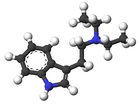
Back دی اتیل تریپتامین AZB Diethyltryptamin Czech Dietiltriptamina Spanish Dietyylitryptamiini Finnish Diéthyltryptamine French Dietylotryptamina Polish Dietiltriptamina Portuguese Диэтилтриптамин Russian Dietiltriptamin Serbo-Croatian Dietiltriptamin Serbian
This article's factual accuracy is disputed. (October 2011) |
 | |
 | |
| Clinical data | |
|---|---|
| ATC code |
|
| Legal status | |
| Legal status |
|
| Identifiers | |
| |
| CAS Number | |
| PubChem CID | |
| DrugBank | |
| ChemSpider | |
| UNII | |
| KEGG | |
| ChEMBL | |
| CompTox Dashboard (EPA) | |
| Chemical and physical data | |
| Formula | C14H20N2 |
| Molar mass | 216.328 g·mol−1 |
| 3D model (JSmol) | |
| Melting point | 169 to 171 °C (336 to 340 °F) |
| |
| |
| | |
DET, also known under its chemical name N,N-diethyltryptamine and as T-9,[2] is a psychedelic drug closely related to DMT and 4-HO-DET. However, despite its structural similarity to DMT, its activity is induced by an oral dose of around 50–100 mg, without the aid of MAO inhibitors, and the effects last for about 2–4 hours.
- ^ Anvisa (2023-07-24). "RDC Nº 804 - Listas de Substâncias Entorpecentes, Psicotrópicas, Precursoras e Outras sob Controle Especial" [Collegiate Board Resolution No. 804 - Lists of Narcotic, Psychotropic, Precursor, and Other Substances under Special Control] (in Brazilian Portuguese). Diário Oficial da União (published 2023-07-25). Archived from the original on 2023-08-27. Retrieved 2023-08-27.
- ^ "Erowid DET Vault : Chemistry". Retrieved 2008-01-08.